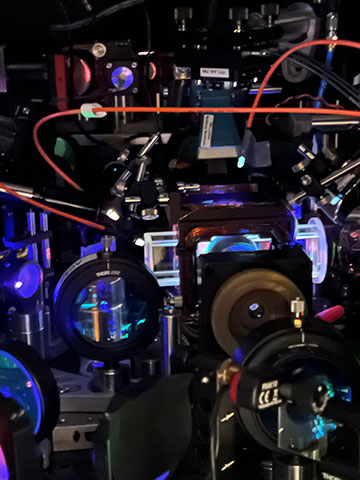
In the experiment, atoms trapped in the glass cell at the center of the picture are manipulated with light beams to perform complex logical algorithms. [Image: Lukin Group, Harvard University]
A research team in the United States has reportedly built a quantum processor that for the first time demonstrates the key elements needed for reliable and scalable quantum computing (Nature, doi: 10.1038/s41586-023-06927-3). By encoding information in so-called logical qubits―which exploit a number of physical qubits to provide the redundancy needed to correct for the errors that limit the performance of today's quantum machines―the processor can execute hundreds of gate operations and run large-scale quantum algorithms.
Physical to logical
The programmable architecture, known as a neutral atom array, is composed of arrays of ultracold rubidium atoms trapped in optical tweezers. The quantum states of the atoms are controlled and manipulated using a series of acousto-optic deflectors (AODs) that create large and reconfigurable grids of light beams, which achieves arbitrary connectivity between the qubits. Previous experiments have also shown that the physical qubits in this system can be entangled to yield two-qubit gate operations with low error rates.
In this new work, Mikhail Lukin, Harvard University, USA, and colleagues exploited optical multiplexing to create 48 logical qubits from 280 physical qubits, a marked improvement on other recent demonstrations that have produced two logical qubits and a single entangling gate. The multiplexing scheme exploits one of the AODs to produce light beams that illuminate all of the physical qubits within a single logical unit, in effect instructing all of them to perform the same operation at the same time.
This approach is intrinsically fault-tolerant because each physical qubit in the logical block is addressed independently, preventing any physical errors from escalating into a logical fault. A similar strategy enabled the team to create fault-tolerant entangling gates for logical qubits in a single parallel step.
Exploiting error correction
The researchers tested their approach by using the entangling gates to create logical qubits based on so-called GHZ quantum states, achieving a fidelity of 72% for the fault-tolerant algorithm and more than 99% with the addition of postprocessing error correction. They also configured complex logical circuits to run a specific type of algorithm that is difficult to simulate classically, which showed that error correction can also enhance the performance of quantum simulations.
The researchers tested their approach by using the entangling gates to create logical qubits based on so-called GHZ quantum states.
"Although there are still challenges ahead, we expect that this new advance will greatly accelerate the progress toward large-scale, useful quantum computers," Lukin commented. Indeed, the researchers believe that their current architecture can readily be scaled to more than 10,000 physical qubits by optimizing the control methods and increasing the laser power.
